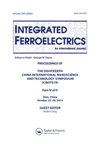batio3 /环氧树脂纳米复合材料作为柔性储能器件
IF 0.7
4区 工程技术
Q4 ENGINEERING, ELECTRICAL & ELECTRONIC
引用次数: 0
摘要
摘要本文制备了环氧树脂与钛酸钡(BT)之间的纳米复合材料,用于柔性储能器件。将环氧树脂与BT相均匀混合,浇铸成圆盘状。采用XRD和FTIR对复合材料的相形成和化学性质进行了表征。用LCR计测量了各样品介电性能的频率依赖性。为了计算材料的能量密度,还研究了极化磁滞回线。结果表明,纳米复合材料的介电常数和损耗与频率无关,εr和tanδ值随BT用量的增加而增大。此外,在体系中加入50% BT后,纳米复合材料的能量密度比纯环氧树脂提高了5倍,而能量损失密度急剧下降。BT/环氧树脂纳米复合材料的介电性能和能量密度随BT含量的变化而变化,并且强烈依赖于BT纳米颗粒的孔隙率和分布。致谢致谢致谢致谢致谢致谢致谢致谢致谢致谢致谢致谢致谢致谢致谢致谢致谢致谢致谢致谢致谢致谢致谢致谢致谢致谢致谢致谢致谢致谢致谢致谢致谢致谢致谢致谢致谢致谢致谢致谢致谢致谢致谢致谢致谢致谢致谢致谢致谢致谢致谢致谢致谢致谢致谢致谢致谢致谢致谢致谢致谢致谢致谢致谢致谢披露声明作者未报告潜在的利益冲突。本项目由泰国国家研究委员会(NRCT)资助。N. Vittayakorn的工作是由蒙库特国王理工学院资助的,拨款编号:KREF116501。本文章由计算机程序翻译,如有差异,请以英文原文为准。
BaTiO 3 /Epoxy Resin Nanocomposites as Flexible Energy Storage Devices
AbstractIn this work, nanocomposites between the epoxy resin and barium titanate (BT) were prepared in order to use as flexible energy storage devices. The epoxy resin and BT phase were homogeneously mixed and cast into a disk shape. Phase formation and chemical properties of these nanocomposites were identified via XRD and FTIR methods, respectively. Frequency dependence of dielectric properties for all samples was measured by LCR meter. The polarization hysteresis loops were also investigated in order to calculate the energy density of materials. From the results, it was found that the dielectric constant and loss of these nanocomposites are independent of frequency and the εr and tanδ values tend to increase with increasing BT amount. Moreover, after adding 50% of BT into the system, the energy density of nanocomposites is increased by five times compared with the pure epoxy resin while the energy loss density sharply decreases. The dielectric properties and the energy density of BT/epoxy resin nanocomposites change with BT content and strongly depend on porosity and the distribution of BT nanoparticles.Keywords: Epoxy resinbarium titanatenanocompositeenergy storage AcknowledgmentsThe authors acknowledge the facilities, and technical assistance from Nanotechnology and Materials Analytical Instrument Service Unit (NMIS) of College of Materials Innovation and Technology, King Mongkut Institute of Technology Ladkrabang.Disclosure StatementNo potential conflict of interest was reported by the author(s).Additional informationFundingThis project is funded by National Research Council of Thailand (NRCT). The work of N. Vittayakorn was funded by King Mongkut’s Institute of Technology Ladkrabang under grant no. KREF116501.
求助全文
通过发布文献求助,成功后即可免费获取论文全文。
去求助
来源期刊

Integrated Ferroelectrics
工程技术-工程:电子与电气
CiteScore
1.40
自引率
0.00%
发文量
179
审稿时长
3 months
期刊介绍:
Integrated Ferroelectrics provides an international, interdisciplinary forum for electronic engineers and physicists as well as process and systems engineers, ceramicists, and chemists who are involved in research, design, development, manufacturing and utilization of integrated ferroelectric devices. Such devices unite ferroelectric films and semiconductor integrated circuit chips. The result is a new family of electronic devices, which combine the unique nonvolatile memory, pyroelectric, piezoelectric, photorefractive, radiation-hard, acoustic and/or dielectric properties of ferroelectric materials with the dynamic memory, logic and/or amplification properties and miniaturization and low-cost advantages of semiconductor i.c. technology.
 求助内容:
求助内容: 应助结果提醒方式:
应助结果提醒方式:


